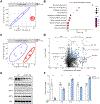Ketohexokinase-C regulates global protein acetylation to decrease carnitine palmitoyltransferase 1a-mediated fatty acid oxidation
- PMID: 36822479
- PMCID: PMC10679901
- DOI: 10.1016/j.jhep.2023.02.010
Ketohexokinase-C regulates global protein acetylation to decrease carnitine palmitoyltransferase 1a-mediated fatty acid oxidation
Abstract
Background & aims: The consumption of sugar and a high-fat diet (HFD) promotes the development of obesity and metabolic dysfunction. Despite their well-known synergy, the mechanisms by which sugar worsens the outcomes associated with a HFD are largely elusive.
Methods: Six-week-old, male, C57Bl/6 J mice were fed either chow or a HFD and were provided with regular, fructose- or glucose-sweetened water. Moreover, cultured AML12 hepatocytes were engineered to overexpress ketohexokinase-C (KHK-C) using a lentivirus vector, while CRISPR-Cas9 was used to knockdown CPT1α. The cell culture experiments were complemented with in vivo studies using mice with hepatic overexpression of KHK-C and in mice with liver-specific CPT1α knockout. We used comprehensive metabolomics, electron microscopy, mitochondrial substrate phenotyping, proteomics and acetylome analysis to investigate underlying mechanisms.
Results: Fructose supplementation in mice fed normal chow and fructose or glucose supplementation in mice fed a HFD increase KHK-C, an enzyme that catalyzes the first step of fructolysis. Elevated KHK-C is associated with an increase in lipogenic proteins, such as ACLY, without affecting their mRNA expression. An increase in KHK-C also correlates with acetylation of CPT1α at K508, and lower CPT1α protein in vivo. In vitro, KHK-C overexpression lowers CPT1α and increases triglyceride accumulation. The effects of KHK-C are, in part, replicated by a knockdown of CPT1α. An increase in KHK-C correlates negatively with CPT1α protein levels in mice fed sugar and a HFD, but also in genetically obese db/db and lipodystrophic FIRKO mice. Mechanistically, overexpression of KHK-C in vitro increases global protein acetylation and decreases levels of the major cytoplasmic deacetylase, SIRT2.
Conclusions: KHK-C-induced acetylation is a novel mechanism by which dietary fructose augments lipogenesis and decreases fatty acid oxidation to promote the development of metabolic complications.
Impact and implications: Fructose is a highly lipogenic nutrient whose negative consequences have been largely attributed to increased de novo lipogenesis. Herein, we show that fructose upregulates ketohexokinase, which in turn modifies global protein acetylation, including acetylation of CPT1a, to decrease fatty acid oxidation. Our findings broaden the impact of dietary sugar beyond its lipogenic role and have implications on drug development aimed at reducing the harmful effects attributed to sugar metabolism.
Keywords: Fructose; Ketohexokinase; Nonalcoholic fatty liver disease; SIRT2; carnitine palmitoyltransferase 1a; fatty acid oxidation; mass spectrometry.
Copyright © 2023 European Association for the Study of the Liver. Published by Elsevier B.V. All rights reserved.
Conflict of interest statement
Conflict of interest
SS receives grant funding from Alnylam Pharmaceuticals, Inc., to study KHK as a target for management of NAFLD. No other conflicts of interest are reported.
Please refer to the accompanying ICMJE disclosure forms for further details.
Figures







References
-
- Malik VS, Hu FB. Sweeteners and risk of obesity and type 2 diabetes: the role of sugar-sweetened beverages. Curr Diab Rep 2012;12:195–203. - PubMed
Publication types
MeSH terms
Substances
Grants and funding
LinkOut - more resources
Full Text Sources
Molecular Biology Databases
Miscellaneous

